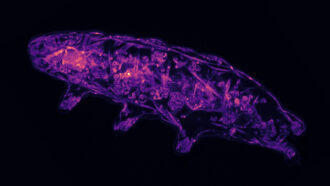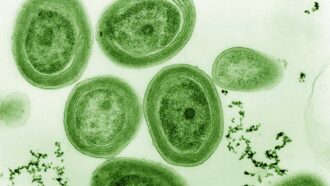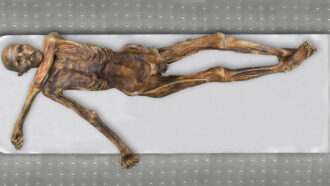
Tina Hesman Saey
Senior Writer, Molecular Biology, Science News
Science News senior writer Tina Hesman Saey is a geneticist-turned-science writer who covers all things microscopic and a few too big to be viewed under a microscope. She is an honors graduate of the University of Nebraska-Lincoln where she did research on tobacco plants and ethanol-producing bacteria. She spent a year as a Fulbright scholar at the Georg-August University in Göttingen, Germany, studying microbiology and traveling. Her work on how yeast turn on and off one gene earned her a Ph.D. in molecular genetics at Washington University in St. Louis. Tina then rounded out her degree collection with a master’s in science journalism from Boston University. She interned at the Dallas Morning News and Science News before returning to St. Louis to cover biotechnology, genetics and medical science for the St. Louis Post-Dispatch. After a seven year stint as a newspaper reporter, she returned to Science News. Her work has been honored by the Endocrine Society, the Genetics Society of America and by journalism organizations.

All Stories by Tina Hesman Saey
-
 Humans
HumansBiological sex is more complex than just male or female
Trying to define sex with just two options fails to reflect the wide range of natural variation in human genetics, hormones and biology.
-
 Health & Medicine
Health & Medicine2025’s Texas measles outbreak is a lesson in the value of vaccines
The outbreak shows that a near absence of once-common childhood diseases — like measles — is not evidence that vaccines are unnecessary.
-
 Animals
AnimalsIn 2024, bird flu posed big risks — and to far more than birds
Cows, elephant seals and polar bears are among unexpected bird flu casualties. Learn about potential risks to them, to people and to our food supplies.
-
 Animals
AnimalsCan furry pets get H5N1 bird flu and spread it to us?
The 2024 pandemic-style bird flu circulating in birds has shown up in cats and other pet species.
-
 Genetics
GeneticsThe discovery of microRNA wins the 2024 Nobel Prize in physiology
Victor Ambros and Gary Ruvkun discovered tiny snippets of genetic material, called microRNAs, that play a big role in making sure cells work as they should.
-
 Animals
AnimalsFreeze-drying turned a woolly mammoth’s DNA into ‘chromoglass’
The 3-D structure of this now-glassy DNA revealed similarities — and differences — between woolly mammoths and elephants.
-
 Planets
PlanetsThe desert planet in ‘Dune’ is pretty realistic, scientists say
Humans could live on the fictional planet Arrakis from Dune. But thankfully giant sandworms probably could not.
-
 Health & Medicine
Health & MedicineA new type of immune cell may cause lifelong allergies
These special memory cells were present in people with allergies and absent in those without.
-
 Animals
AnimalsTardigrades survive harsh conditions by almost dying. Here’s how
Under stress, a chemical change signals these water bears to switch between live and mostly dead.
-
 Life
LifeBacterial fossils exhibit earliest hints of photosynthesis
Microscopic fossils from Australia suggest that some bacteria evolved structures for oxygen-producing photosynthesis by 1.78 billion years ago.
-
 Archaeology
ArchaeologyÖtzi the Iceman’s DNA reveals his looks and ancestry
A reanalysis of the ancient guy’s genes shows he was balding and had dark skin. He also had an unusual amount of early farmer ancestry.
-
 Chemistry
ChemistryCreation of quantum dots wins 2023 chemistry Nobel
The award honors three scientists who discovered and built quantum dots, which are now used in everything from TVs to medical tools.